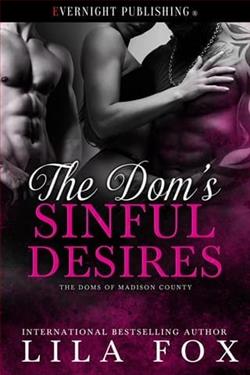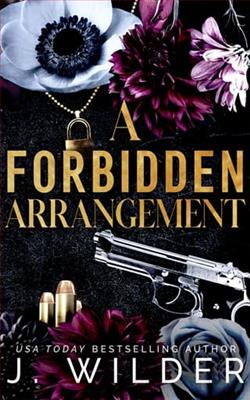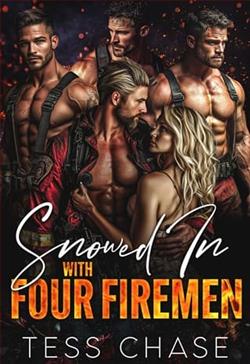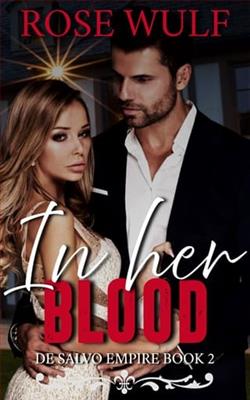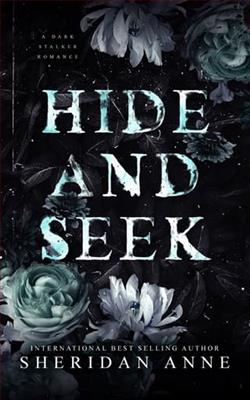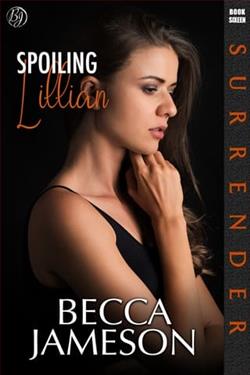Page 16 of The Mortal Queen
“This is your home now,” Lir said.
The queen turned to meet the fae king’s eyes only to find him studying her, watching her. She too would’ve been curious to see her expression. To witness the reaction of any mortal who beheld this fae land. Perhaps she was the first.
“This is Annwyn.”
CHAPTER VI
Lir’s cavalcade of fae knights greeted Aisling, Galad, and the fae king himself on the other side of the waters. Aisling rode, once again, on Lir’s stag as they entered Annwyn’s corridors. The fae king held the queen’s waist with one arm and the reins with another. A gesture, a physical contact that heated every inch of Aisling’s skin. It was a performance. A showcase of their political union.
The streets spilled over with fae subjects, each craning their elegant necks to catch a glimpse of the mortal queen. Males, females, few children, large and mighty and beautiful. Tangled in black, knotted runes, braids, and symbols tattooed into their iridescent dark or gold, pink or pale skin. So unlike the ghoulish aberrations she’d anticipated. In fact, it was difficult to believe mortals lived under the same grey-clad sky as this preternatural civilization. That they shared the North’s breath. Its wistful sighs and verdant earth.
And just as the cave’s threshold implied, many of Lir’s subjects bore wings. Large, nearly translucent appendages, resembling those of a wasp. But these wings bore no color of their own, rather reflected the light around them as the fair folk danced barefoot, sang sweet tunes, puffed clouds of pollen, carpeted the flagstone streets with thistles, heathers,and frosty avens.
“How many of you are there?” Aisling asked Lir, the fae king waving at a female who’d called him by name. A female whose long tresses arrived at her hips, braided through with bluebells. Or perhaps the bluebellswereher hair, sprouting from her scalp. Her angled cheekbones shelving a kaleidoscope of butterflies.
Lir was silent for a long moment, until he, at last, spoke: “A couple thousand here in Annwyn.”
Aisling surveyed the crowds, the fair folk filling the glistening streets, pouring from the strange shops and houses, running through the surrounding forest, peering from their homes in the treetops. To Aisling, it seemed there were so few. Nothing compared to Tilren’s overflowing thoroughfares where peasants and commoners burst at the seams of their northern kingdom. Where commonfolk trampled one another to navigate the cobbled paths.
In addition to the fair folk, there were other creatures who populated this city; animals that interrupted Aisling’s beating heart. Furry beasts the queen recognized, whether it be their likeness on parchment or over Tilren’s walls: badgers, foxes, rabbits, bears who, here in Annwyn, did not crawl or growl but stood and walked on two feet, clapping their paws and speaking through their muzzles. Magic. As distilled and potent as the fog rolling in from the highland peaks.
Aisling did her best not to gawk, instead averting her attention to the stores lining every corridor, the same sort of shops and services one would encounter in mortal territory—tailors, smiths, bakeries, homes—but somehow laced with fae taste, skill and culture. Apples, peaches, plums, and berries bubbled from the vines and cloaks of green that smothered everything in their reach. In fact, many of the cottages were carved into the trees themselves, spindly, spiral staircases winding around the girthy trunks and into the canopies. The highest branches braided in colorful ribbons andcylindrical chimes that sang with every passing breeze. A breeze that smelled of hogweed seeds, ramson capers, powdered peppery bolete, spignel leaf, and scarlet incense. Nothing like the rot vegetating in Tilren, a product of mass waste from overpopulation.
Some cheered as the royal procession entered. Screamed their king’s name. Most scowled at Aisling, regarding her with disgust and contempt. Even loathing, tightening their fists around their weapons or at their sides as if they’d like nothing more than to harm the mortal invading this stolen ground. As the procession passed, they were no doubt already dreaming of the ways they’d nail her head to a pike to avenge what the mortals had stolen after years of warring. But said reaction was perhaps the only aspect of the fair folk and Annwyn that Aisling had accurately predicted. For everything else left her speechless, searching for words.
One Aos Sí, in particular, caught her attention, a male bent below the awning of a silversmith. He tempered a thin stretch of metal, pausing only to follow the crowd’s gaze to the royal procession. His blonde hair was braided away from his face. It lay across his broad back like a fox’s tail, revealing an ugly scar that cut diagonally across his seething expression. The wound had removed his right eye, leaving an angry, knotted lesion. But that was not the only injury he bore. His left arm had been severed at the elbow, a wound to match his lost eye. Both were marked by crimson, expanding like an open hand till the wounds dissolved further up his appendage and across his nose.
Was this what iron did to fae flesh? Were these the marks iron left if such blows didn’t kill them in the first place?
Suddenly Iarbonel’s dagger, hidden away by Aisling’s hip, felt heavier. It weighed heavy on her arm, threatening to fling her to the ground and off the stag’s back. The fae smithy’s knuckles grew white, clenching his tools as his glare deepened. Aisling knew he wished her dead. Nemed was right.Here in this odd world, Aisling represented all of mankind and in so doing, bore all the fault for the crimes of mortals, in fae eyes at least. Every morsel of their hatred was now concentrated into a single person, Aisling. A queen who was the newfound symbol of their enemy, prancing into Annwyn.
Aisling didn’t blame the Aos Sí for their blatant disregard. Her father had slaughtered hundreds of their kind, tactfully finding ways to rid his land of the fair folk without engaging in direct combat, for mortals would sooner perish than claim victory on a battlefield, face-to-face with the Aos Sí. But Aisling had seen Starn return, his clothes covered in soot and ash, a day spent paving the earth for mortal expansion. Nemed was clever. Although he couldn’t match their strength or power in direct combat, he could outsmart them. Which is exactly what he and all the mortal kings and chieftains before him had done for centuries.
And now, a mortal girl arrived to rule them. All in the name of peace. But that was a mere illusion. Aisling had no power here. Only the appearance of it. She was more a slave than a queen amongst the Aos Sí and she would always be considered as such. To think otherwise would be foolish.
Aisling swallowed her sympathy, reminding herself that the Aos Sí had laid claim to Clann Neimedh’s land, built this fae civilization on stolen northern territory, forced mankind from the rivers and highlands and groves to hide behind their iron walls. Nemed and the other mortal sovereigns had protected their race. Generously, gallantly sheltered humans from the fury of this savage, barbaric fair folk whose nature was to reap violence.
“They will try to deceive you. They will spin lies as easily as they spin their thread,” Aisling repeated to herself, savoring the memory of her father’s voice.
The architecture in Annwyn differed from anything she’d experienced in the mortal lands, each beam and pillar andvaulted roof, carved with elegant detail––flowers, animals, fae faces etched into the pale oak or stone. And the wattle and daub homes that lined the periphery of Tilren were nowhere to be found here. Only the work and materials fae fingers could both manipulate and craft, Aisling was realizing. Perhaps through magic and magic alone.
Through the hollowed-out trees, atop the undulating flagstone paths, beneath the trickling waterfalls, the procession wove itself up the mountain and towards the castle, admiring its kingdom below. Moss, algae, roots, and other flora clung to every surface of the summit like a lovely, sentient disease, infecting everything it beheld. Not even the altitude nor the chilled northern air could strike fear in these forests, growing as strongly, as potently as they had below.
Lir was sovereign to an immense dominion, so much larger than Tilren. A society occupying even the canopies of the trees—limitless space and freedom. So unlike the mortal lands spilling over with man, woman, and child; kingdoms whose subjects lived atop one another in narrow, congested alleys, spreading diseases like wildfire.
Lir’s castle itself was sculpted from the summit. A mountain cutting through the greenwood, white stone notched into turrets whose peaks were blanketed either by clouds or prehistoric elms, covered parapet walks suspended in the air, a steepled chapel whose stained glass windows glittered in the evening light, and walls dressed in vines and flowers.
Six sentinels stood guard on either side of the drawbridge to the castle. A drawbridge that connected the mountain to the forest earth, separated by a steep drop where frothing rapids swam far below. But these sentinels were no fae. They were great, bipedal bears, strapped with fae armor and equipped with greatswords and shields, bowing to Lir as he approached in near-perfect unison. What did they protect the castle from, Aisling wondered? Were theAos Sí a threat also to themselves?
“Are these sentinels from your military?” Aisling asked over the clack of the stag’s hooves on stone, surveying their intricate yet elegant armor, armor that matched the knights surrounding her, their thick, umber coats, their long muzzles snapped shut to hide a collection of razor-sharp teeth, Aisling had no doubt. Did her father know of these animals? These familiar creatures that stood and acted like men?
“They’re trained soldiers, yes, but our military comprises all of Annwyn,” Galad replied before Lir, nodding to the sentries as their procession passed.
“You mean even the”—Aisling hesitated, unsure what to call these strange beasts—“commonersfight?” Aisling asked, aware that perhaps these were not the most appropriate of questions considering her position. Nevertheless, if she were to live here, she would want to understand how their society worked. To understand the fae themselves.
“Aye, the commoners, the noble people. Everyone, save for the children,” Galad said. Aisling considered the fae knight, meeting his sapphire eyes. The mortal queen had never heard of such a society, one where every member was born for battle. What had she expected? The fair folk were savage. A folk the Forbidden Lore was said to describe as a tribe of legendary heroes. Warriors forged in enchantments, curses, and the bending of the elements.
“Where do you think their markings come from?” Galad asked rhetorically, turning to face the castle.









